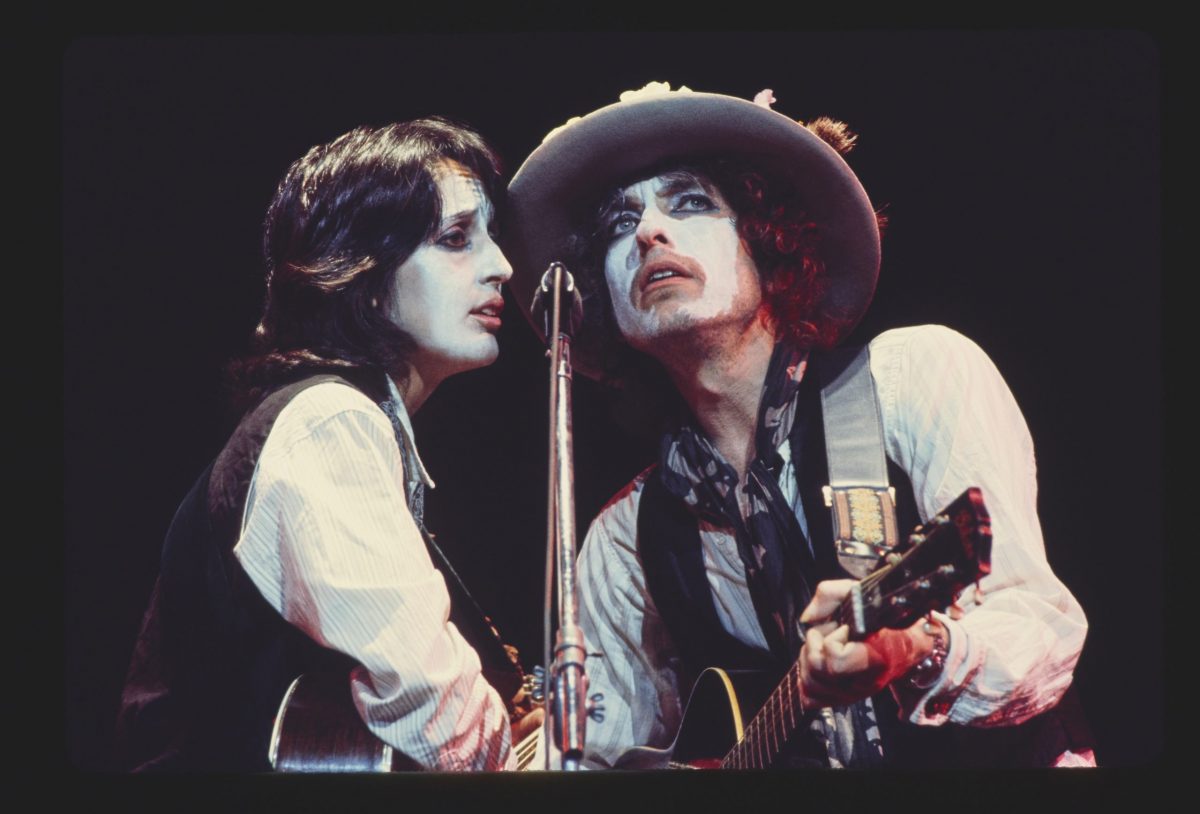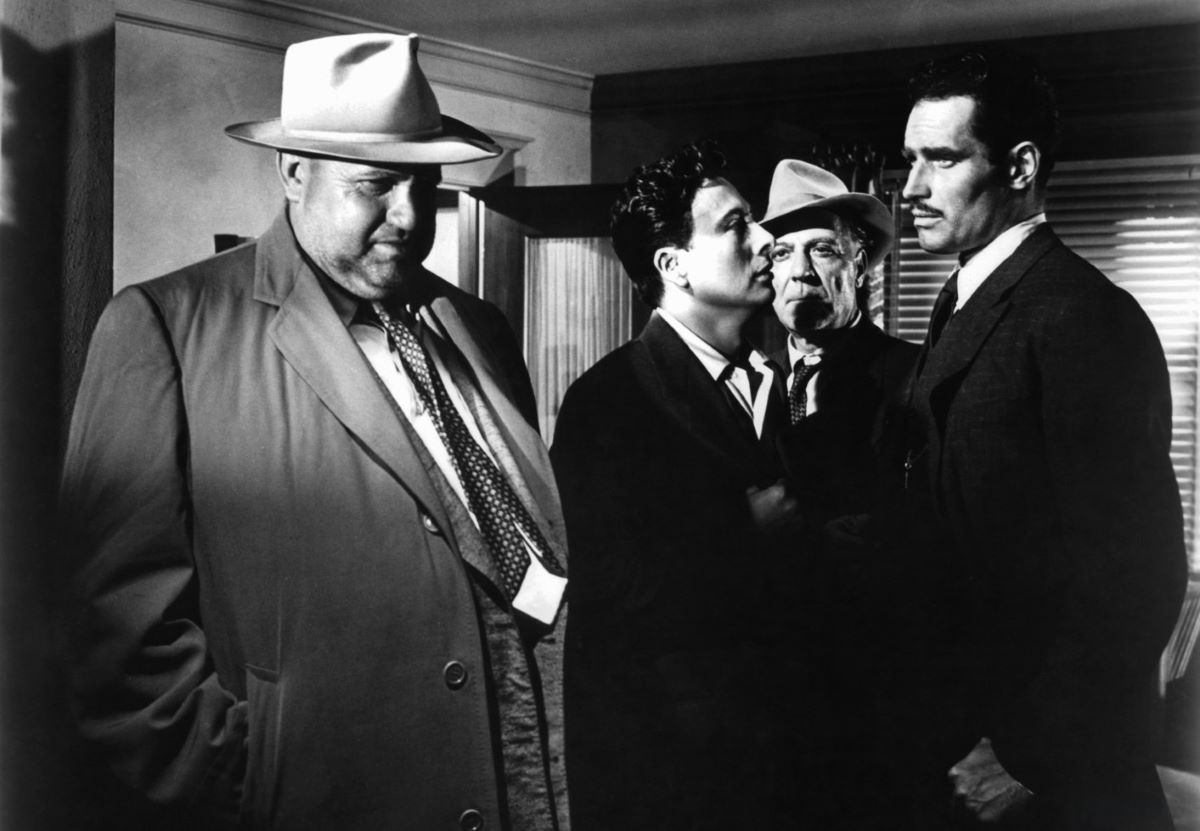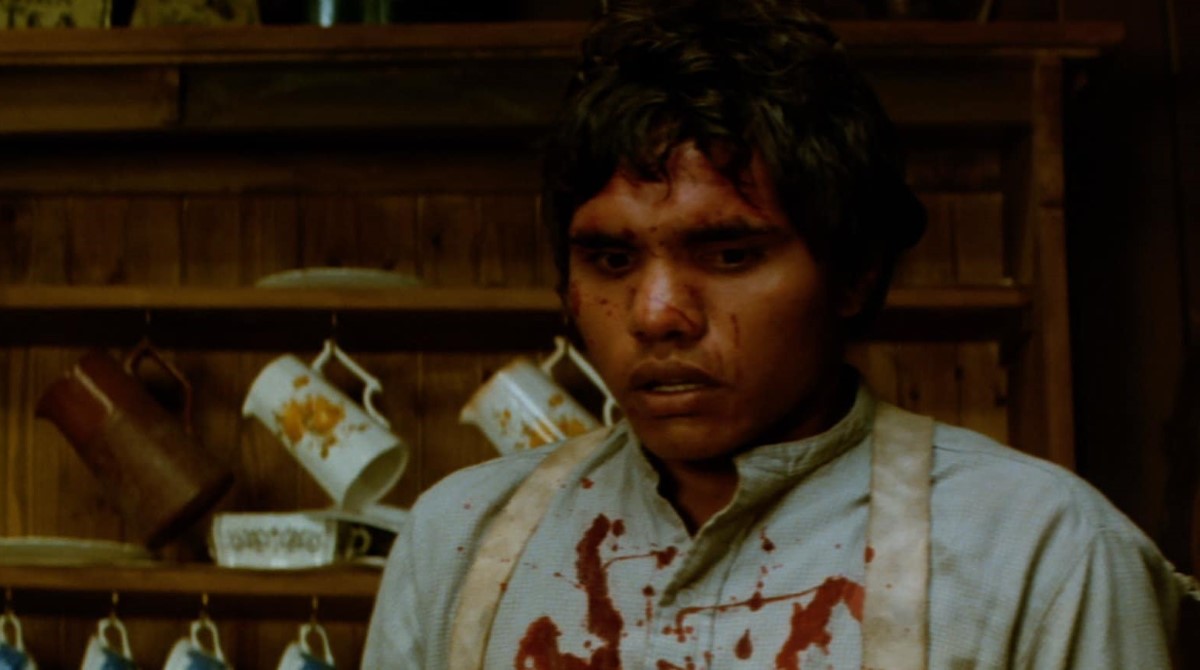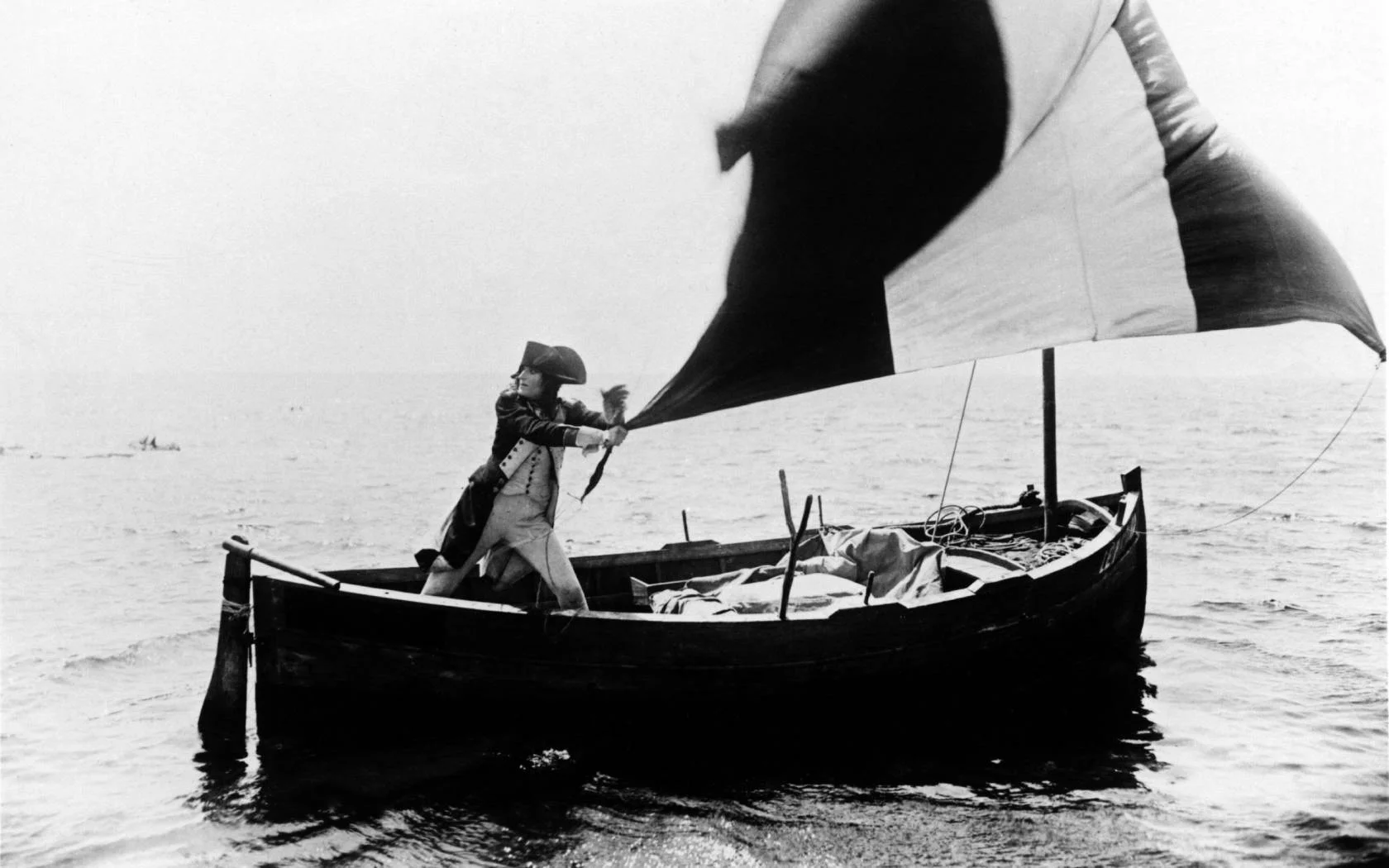The Calvary Gig
by Pauline Kael
Suppose some people in their late teens or early twenties, imagining in their plain innocence that Bob Dylan is a famous composer-singer, no more, no less, go to see his film Renaldo and Clara — what can they make of it? During the opening titles, Dylan is heard singing ‘When I paint my masterpiece’ and then we see a small man on stage performing; he wears a hat straight across his forehead, like Billy Jack, and a clear plastic mask with a twisted big mouth and a stretched-out nose. Eventually, he pulls off the disguise and we see Dylan’s scowling, impassive face, but during the three hours and fifty-two minutes of the movie Dylan puts on other masks, or paints his cheeks and nose white and then shows us the sweat pouring through the paint. The film was shot mostly in the course of a Bicentennial (1975-6) tour (the show was called the Rolling Thunder Revue) and the performance footage, with the singers and musicians lighted in strong, bright, near-psychedelic colour against black or deep-blue backgrounds, is handsomely photographed and has good sound quality. But we never get the build-up of excitement that one can feel at a live performance (and sometimes at a performance film, too), because Renaldo and Clara keeps cutting away from the stage to cinéma-vérité fantasies of Dylan’s life, which occupy more than two-thirds of the movie. In this material, Dylan tries some role-playing, camouflage, going incognito, and he’s joined by Joan Baez, Sara Dylan, Ronee Blakley, Allen Ginsberg, Arlo Guthrie, Sam Shepard; Ramblin’ Jack Elliott, Harry Dean Stanton and a large cast of other friends and musicians, who half-heartedly assume make-believe identities. Everything circles around Dylan who, despite his many guises, is always the same surly, mystic tease.
Although the film was made by Bob Dylan, he didn’t direct it (nobody did). The cameramen are following a floating crap game — panning, zooming, frantically trying to catch whatever looks promising. And he didn’t write it: the participants seem to be saying whatever comes into their heads. (Only David Blue, working a pinball machine and telling us how he first met Bob Dylan, shows an instinctive feeling for the camera and some wit.) But Dylan must certainly have been in control of the editing. He has given himself more tight close-ups than any actor can have had in the whole history of movies. They are so close you don’t see the whole face — only from under the brims of his hats down to midway across the chin. His eyes are heavily lined in black, for a haunting, androgynous effect, and you get the skin blemishes, the face hair, the sweat and bad capillaries, and, when he sings, the upper lip pulling back in a snarl and the yellow teeth like a crumbling mountain range. He is overpoweringly present, yet he is never in direct contact with us — not even when he performs. We are invited to stare at the permutations of his masked and unmasked face in close—up to perceive the mystery of his elusiveness — his distance.
This is a shocking miscalculation, because, of course, Bob Dylan is no longer the oracle, perhaps not even to his entourage and his troupe of associates. In the Sixties, his songs were said to have defined a generation, but what he does on the screen here is painfully out of key with the times. Where is the audience that will see him as he sees himself? He and Allen Ginsberg visit a Catholic grotto in Lowell, Massachusetts, and as they examine the glassed-in sculptures, Ginsberg, in the role of The Father, explains the Stations of the Cross to him. Dylan’s songs include his own ‘What will you do when Jesus comes?’ and ‘Knockin’ on heaven’s door’. A street philosopher holding forth in a diner says, ‘The people still love Dylan and they’ll still follow Dylan.’ And wherever Dylan goes — visiting Kerouac’s grave and observing, ‘I want to be in an unmarked grave’, or tramping in the Vermont snow in his Hasidic-pathfinder costume — there is an aura about him. The camera keeps saying: this is no ordinary man who walks among you. In one sequence, he pays a visit to the Tuscarora Indians and receives homage with a humility unrivalled by Jeffrey Hunter in King of Kings. It’s not just people previously unexposed to Dylan who are likely to be repelled by his arrogant passivity; even those who idolised him in the Sixties may gag a little.
The Bob Dylan they responded to was a put-on artist. He was derisive, and even sneering, but in the Sixties that was felt to be a way of freaking out those who weren’t worthy of being talked to straight. Implicit in the put-on was the idea that the Establishment was so fundamentally dishonest that dialogue with any of its representatives (roughly, anyone who wore a tie) was debased from the start. And Dylan was a Counterculture hero partly because of the speed and humour of his repartee. (Playboy: ‘Did you ever have the standard boyhood dream of growing up to be President?’ Dylan: ‘No. When I was a boy, Harry Truman was President. Who’d want to be Harry Truman?’) In Renaldo and Clara his mocking spirit is just bad news: he’s a sour messiah. After you’ve watched him for a few hours, in his medicine-man paint, his superannuated hippie clothes and the big hats that sprout feathers and flowers and plumes, you may begin to wonder if his visionary double-talk isn’t just another form of the usual showbiz patter of people who keep looking back. The chief duty of David Blue’s monologues at the pinball machine is to give us the legend of how things used to be, in the Sixties — to place Dylan in history for those who never knew or have forgotten. When Blue explains how Dylan came to write ‘Blowin’ in the wind’, it’s not very different from Comden and Green on stage reminiscing about their great days, the Fifties.
In recent years, in Hollywood, industry executives have been dumbfounded to discover that awesomely rich singers and TV stars will take a financial loss for a shot at the movies. Even for people whose faces and voices are known to many more millions than ever went out to the pictures, working in the movies still represents the real glamour and the real challenge. And artists whose reputations might suggest that they are above such dreams may also want to be movie stars. At the extreme, for Bob Dylan as for Norman Mailer, stardom isn’t enough. Though these artists don’t — can’t — give to movie-making the struggle to find their way which went into their primary art, they take on the burden of the film-maker as well as of the star. Except for a streak of messianism, Mailer’s writing and Dylan’s songs could hardly be more different, but when these men turn to film the results are startlingly similar. For all Mailer’s theoretical bullslinging about how movies should be made and for all Dylan’s forlorn holiness, they both set themselves in the centre of a group of friends, admirers, old flames and flunkies, and, while cinema-verite camera crews keep shooting, they play-act identity games. It’s what Louis and Marie Antoinette might have done at Versailles if only they’d had the cameras.
Like Mailer, Dylan is an artist who intended to do something in advance of conventional movies — more poetic, more ‘true’ — yet Renaldo and Clara, like Mailer’s Wild 90, Beyond the Law and Maidstone, is marked by an absence of artistic intelligence. The picture hasn’t been thought out in terms of movement or a visual plan. Dylan merely gives his actor friends some clues as to what he’d like them to do and they improvise, without reference to what has gone before or what will follow. Thousands upon thousands of feet of film are exposed and then editors, with ‘the film-maker’ supervising, try to cut it all into some sort of shape. It’s a lazy, profligate way to make a movie; the technicians are forced to try to compensate for the fact that nobody has done the thinking. There were four camera crews working simultaneously on Renaldo and Clara and, with the compositions left to the cameramen, there’s no overall clarity of style.
Dylan has been involved with movies at least since the mid-Sixties; Don’t Look Back, in which he starred (and which his manager helped produce) was about his 1965 tour of Britain and showed him as a sensitive artist harassed by people who didn’t understand his art. He put them on mercilessly and squelched them with satisfaction. Renaldo and Clara has the same ridicule of outsiders (in one sequence, the elderly women at a poetry reading are rattled by a hipster’s deadpan remarks introducing Allen Ginsberg); the same self-protective way of tossing out thoughts (one can never be sure whether Dylan means what he says); and the same sweet-Jesus liberalism (in Don’t Look Back, the footage of the British tour was interrupted by a sequence of Dylan playing for Mississippi sharecroppers, while in Renaldo and Clara the footage of the Rolling Thunder tour is interrupted by man-on-the-street interviews with Black people about the Rubin Carter case, which seem included to show us that Bob Dylan cares more about Black people than they do themselves). Renaldo and Clara is a continuation of Don’t Look Back; it hasn’t solved any of that film’s problems, it just extends them over almost three times the length. In movies, you can force connections in the cutting room and think you’re using associational editing, but the result may still affect viewers as random footage spliced together. The variable colour values in Renaldo and Clara and the frequent returns to situations that one thought were finished (for example, to the philosopher and the other men in the diner talking about God’s work and what truth is and how ‘if you follow Bob long enough, maybe you can translate these things,’ or to scenes with several of the women dressed up as hooker senoritas and talking over life’s problems) add to the feeling of randomness. Renaldo and Clara doesn’t take form in the mind, like a movie, even though one can discern the thematic links. They’re not hard to spot, so many of them are biblical.
No matter how skilfully the footage is cut, there’s still a basic discrepancy in using hand-held or shoulder-mounted lightweight cinema-verite equipment on acted scenes and this is particularly apparent when they take place in small rooms. The falseness of the amateur-theatricals acting here is compounded by the fact that the cameramen are bouncing around as if they were shooting a news event. In most Hollywood films, the danger is of set-ups so patterned that the film is static; the danger in this kind of film is that, with the camera necessarily active, the movement will be jumpy. In a backstage scene in which Ronee Blakley and Steve Soles act out a quarrel, the camera is a jack-rabbit leaping from wall to wall, chasing the action. This sequence is so glaringly bad both as improvisation and in terms of film technique that one wonders why Dylan put it in. But it’s followed by Ronee Blakley on stage singing her own song ‘Need a new sun rising’ and then one can guess why. Singing in a rougher, more passionately all-out style than in Nashville, she gives the film a fresh, reckless energy that makes the other performers and Dylan himself seem jaded, familiar. Was the quarrel scene, in which she comes across as a completely undesirable woman, stuck in just ahead of her number to sabotage it? The other women in the movie keep their place; the saintly film-maker may be putting Ronee Blakley in hers.
Sara Dylan has a flirtation scene with Sam Shepard that is like a dnema-verite nightmare. She goes through womanly-wisdom routines while he plays the juvenile and you feel it will never end. Slender and smiling, Joan Baez is pleasantly relaxed (except when she does an arch parody of a gypsy accent). She never takes what’s going on seriously enough to be embarrassing; playing something called The Woman in White, she just seems to be humouring Dylan. But her slightly blank, ironic off-handedness makes the viewer feel a fool for watching and she does more necking than singing. Part of Dylan’s psychodrama here involves a triangle — hot revelations about his past life with Sara Dylan and Joan Baez. With the improvisational techniques he’s using, what is revealed amounts to this: Baez has a soliloquy on the soundtrack about wanting somebody. (The women in this movie are very hard up.) Then she sings a song about her relationship with Dylan, and asks him, ‘What do you think it would have been like if we’d gotten married?’ This is capped by her switching drinks with him; they’re playing Hollywood lovers for us. Somewhere toward the fourth hour, Dylan and Sara Dylan are referred to as Renaldo and Clara, and a little later we sit watching while Sara Dylan gives Dylan a little soft pawing and Baez plays the rejected other woman. And, in one howling moment, he stands between the two women and the camera moves down his torso, as if he were the oak tree of life. This triangle is the big number (Mailer having already played a love scene on screen with his wife). Dylan tries an artistic-film-maker device by having Sara Dylan ride in a carriage and then step out and enter a building to be replaced by Joan Baez, inside the building, wearing Sara’s clothes. Only Dylan could imagine that either of the characters they’re playing has enough identity to transfer. (And in visual terms, he picked the wrong woman for this transfer scene: in long shot, Joan Baez and Ronee Blakley look enough alike to confuse viewers.)
The pretence that Dylan is playing someone named Renaldo collapses when we see how he is received by the Tuscarora Indians. They’re delighted and honoured that Bob Dylan, the star, has come to visit them. And this star, who in his lyrics identifies himself with the ‘poet who died in the gutter’ and the ‘clown who cried in the alley’, reacts as if he were blessing them by his presence. (He wants to be buried in an unmarked grave. Of course. That’s why he’s made a four-hour movie about himself and his pilgrimage.) Is Dylan still so impressed by adulation? Doesn’t he know that even fourth-rate actors in a TV series who rent themselves out to open a supermarket are received as if they were saviours?
New Yorker, 13 February 1978






1 thought on “Renaldo and Clara (1978) – Review by Pauline Kael”
Saddest of films and a humiliation for all. Poor sad Zimmerman